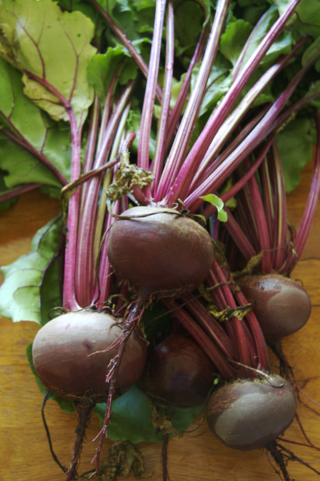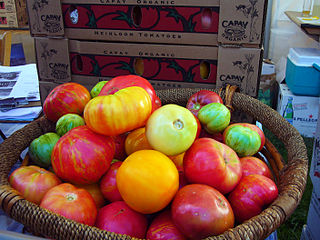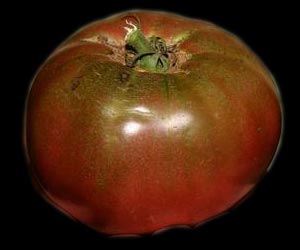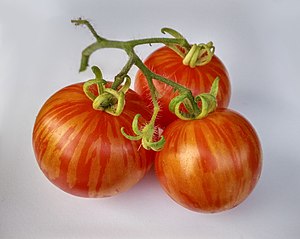
Eggplant, aubergine or brinjal is a plant species in the nightshade family Solanaceae. Solanum melongena is grown worldwide for its edible fruit.

The beetroot is the taproot portion of a beet plant, usually known in North America as beets while the vegetable is referred to as beetroot in British English, and also known as the table beet, garden beet, red beet, dinner beet or golden beet.

An heirloom plant, heirloom variety, heritage fruit, or heirloom vegetable is an old cultivar of a plant used for food that is grown and maintained by gardeners and farmers, particularly in isolated or ethnic minority communities of the Western world. These were commonly grown during earlier periods in human history, but are not used in modern large-scale agriculture.

An heirloom tomato is an open-pollinated, non-hybrid heirloom cultivar of tomato. They are classified as family heirlooms, commercial heirlooms, mystery heirlooms, or created heirlooms. They usually have a shorter shelf life and are less disease resistant than hybrids. They are grown for various reasons: for food, historical interest, access to wider varieties, and by people who wish to save seeds from year to year, as well as for their taste.

A beef tomato or beefsteak tomato is a large tomato. Grown on the plant Solanum lycopersicum, it is one of the largest varieties of cultivated tomatoes, regularly at 20 cm (6 in) in diameter with some weighing 450 g (1 lb) or more. Most are pink or red with numerous small seed compartments (locules) distributed throughout the fruit, sometimes displaying pronounced ribbing similar to ancient pre-Columbian tomato cultivars. While popular among home growers for beef sandwich toppings and other applications requiring a large tomato such as toppings on large steaks, beefsteaks are not grown commercially as often as other types, since they are not considered as suitable for mechanization as smaller slicing tomatoes. Non-commercially, however, they are the most popularly grown tomato in North America.

The Roma tomato or Roma is a plum tomato popularly used both for canning and producing tomato paste because of its slender and firm nature. Commonly found in supermarkets in some countries, Roma tomatoes are also known as Italian tomatoes or Italian plum tomatoes.

Green Zebra is a tomato cultivar with characteristic dark green and yellow stripes. Newer variations blush reddish instead of yellow when ripe. It is more tart than a regular tomato, and it is an early cultivar. Compared to other tomato varieties, it can produce somewhat mealy fruits depending on growing conditions.

The Brandywine tomato is an heirloom cultivar of tomato, with large potato-leaved foliage and large pink beefsteak-shaped fruit. It is popularly considered among the best tasting available.

The tomato is the edible berry of the plant Solanum lycopersicum, commonly known as the tomato plant. The species originated in western South America, Mexico, and Central America. The Mexican Nahuatl word tomatl gave rise to the Spanish word tomate, from which the English word tomato derived. Its domestication and use as a cultivated food may have originated with the indigenous peoples of Mexico. The Aztecs used tomatoes in their cooking at the time of the Spanish conquest of the Aztec Empire, and after the Spanish encountered the tomato for the first time after their contact with the Aztecs, they brought the plant to Europe, in a widespread transfer of plants known as the Columbian exchange. From there, the tomato was introduced to other parts of the European-colonized world during the 16th century.

Cherokee Purple is the name of an old variety of tomato that develops a fruit with a deep, dusky-rose color while maintaining a somewhat greenish hue near the stem when mature for eating. The deep crimson interior and clear skin combination give it its distinctive color. It was one of the first of the darker color group of tomatoes sometimes described as "blacks." Southern Exposure Seed Exchange was the first seed company to offer Cherokee Purple, released in limited quantity in 1993. The Cherokee Purple has become a popular heirloom variety.

Mr. Stripey is a type of heirloom tomato with unusually small leaves and a mix of a yellow and red color that can fool some growers into thinking they are picking an unripe tomato. Under good conditions in size, shape and internal structure it may be considered a "beefsteak". Tigerella is generally smaller than the Mr Stripey variety and the colors are less defined, they actually are two distinct different heirloom varieties. Tigerella isn't as sweet or "low-acid" as the Mr. Stripey variety, either. Like other heirlooms, Mr. Stripey has an appearance that differs considerably from other tomatoes. In coloration, it is mostly somewhat more yellow near the stem and more red towards its underside, with gentle stripes of red and yellow blending into each other along the sides. This coloration may extend into the interior of the fruit, which tends to be more yellow than red.

Pear tomato or teardrop tomato is the common name for any one in a group of indeterminate heirloom tomatoes. There are yellow, orange, and red varieties of this tomato; the yellow variety being most common. They are generally sweet, and are in the shape of a pear, but smaller. They are heirlooms and have 3 common other names, such as the "Red/Orange/Yellow Pear Tomato Plants."
The Big Rainbow heirloom tomato is one of dozens of large fruited yellow tomatoes with red swirls. They have a mild, sweet flavor. The Hillbilly tomato is another similar-coloured tomato.
The Hillbilly Tomato, scientific name Solanum lycopersicum, is an heirloom cultivar originating from West Virginia in the 1800s. There is also a potato-leaf variant named Hillbilly Potato Leaf. The fruit is considered a beefsteak tomato weighing 1-2 pounds. It is round, heavily ribbed and its skin and flesh is orange-yellow with red streaks. The flavor is described "sweet and fruity" and is low in acid.
The Jubilee cultivar of tomato is heavy yielding, low acid, with golden fruit that grow on indeterminate vines. It was released by Burpee Seeds in 1943.
Lillian's Yellow tomato is a late season heirloom tomato collected by Lillian Bruce of Tennessee. She gave seeds to Robert Richardson, after which it found its way into the Seed Savers Exchange yearbook. One of the few bright yellow varieties, Lillian's Yellow Tomato is a potato leaved plant that requires a long growing season. The fruit is meaty, full flavored and contains few seeds.
The Amish Paste heirloom tomato is a plum tomato of Amish origins, that is used for cooking, although it can be eaten raw.

Aunt Ruby's German Green heirloom tomatoes are a cultivar originating with Ruby Arnold, of Greeneville, Tennessee, but achieving great Seed Savers popularity. They are, as the name implies, "green" tomatoes, which really means they are a greenish yellow when fully ripe, but are still tasty when picked early.
Siberian tomato is a type of the common tomato plant. It is referred to as "Siberian" because it can set fruit at 38 °F (3 °C), although it is not particularly frost hardy, despite its name.













